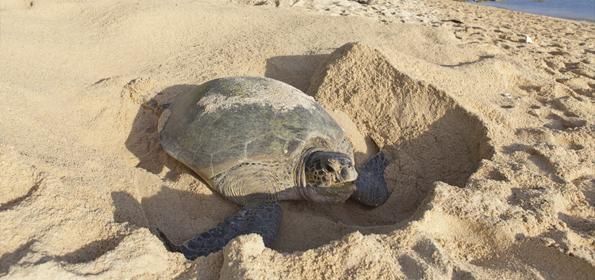[:es]La región de Tortuguero en el Caribe de Costa Rica es, año con año, una zona privilegiada por la naturaleza, la cual nos brinda un espectáculo sin precedentes: el anidamiento y desove de las tortugas marinas Verde (Chelonia mydas) y Baula (Dermochelys coriacea)
Es entre los meses de marzo y junio, en el caso de la tortuga Baula, y julio y octubre, en el caso de la tortuga Verde, que estos animales se acercan a Tortuguero durante las noches para depositar sus nuevos en la playa, hecho que atrae particularmente a turistas extranjeros.
Éstos, acompañados de un guía local debidamente autorizado, se maravillan con todo el proceso que viven los animales desde que salen del mar y hasta que regresan a él.
Es importante resaltar que la tortuga Verde puede llegar a pesar hasta 230 kilogramos, mientras que la Baula es la más grande de todas y su peso, incluso, alcanza los 500 kilos.
UBICANDO EL LUGAR PERFECTO PARA EL DESOVE
Una vez que dejan el agua salada, las tortugas marinas -a paso lento pero muy seguro- comienzan a buscar el sitio ideal en la playa para desovar los huevos. Una vez que lo encuentran empiezan a cavar un nido de entre 50 y 75 centímetros de profundidad.
Como dato curioso se cree que eligen el lugar basadas en la temperatura y humedad de la arena.
Algunos minutos después da inicio el desove, proceso que por ningún motivo debe ser interrumpido.
Cuando la tortuga termina de poner los huevos (pueden llegar a ser hasta 100 o más) un par de horas después, se da a la tarea de cubrirlos con arena, ayudándose de sus aletas traseras. Luego, usa las delanteras para terminar de tapar completamente el hoyo y aplanar la superficie.
Es entonces cuando, agotado, el animal regresa al mar. Nunca más volverá al sitio exacto del desove.
UN NUEVO CICLO DE VIDA SE INICIA EN LAS PLAYAS DE TORTUGUERO
Alrededor de dos meses más tarde, decenas de tortuguitas iniciarán su propia aventura.
A ellas les espera la tarea de dejar sus huevos, excavar la arena unas encima de otras hasta alcanzar la superficie y después aguardar que sea de noche o madrugada para empezar su carrera en grupo hacia el mar.[:en]With its different types of animals, about 2.000 species of plants, 405 of birds and more than 400 of trees, the Tortuguero National Park, at the Costa Rica´s Caribbean coast, is a natural paradise.
Year after year the area of Tortuguero in the Caribbean of Costa Rica turns into a region that´s privileged by nature with an unprecedented spectacle: the nesting and spawning of the Green (Chelonia mydas) and Baula(Dermochelys coriacea) turtles
It´s between the months of March and June, in the case of the Baula turtle, and July and October, for the Green turtle, that these animals come to Tortuguero during the nights to place their eggs at the beach; a situation that´s particularly attractive to foreign tourists.
The tourists, with the company of a local authorized guide, get amazed by the entire process that the animals go through, from the moment they leave the water until they come back to it.
It is important to emphasize that the Green turtle can weigh up to 230 kilograms, while the Baula is much bigger, and can reach about 500 kilos.
SEARCHING THE PERFECT SPOT TO HATCH
Once they leave the salty water –slowly but steady- the sea turtles start looking for the perfect spot at the beach to spawn their eggs. With the perfect place located, they begin to dig a nest between 50 and 75 inches deep. Curiously it´s believed that they chose the place based on the temperature and humidity of the sand.
A couple of minutes later the spawning begins, and it´s a process that under no circumstances should be disturbed.
When the turtle finished laying the eggs (can be up to 100 or even more), a couple of hours later, it stars covering them with sand. The turtle uses its back fins to do this. Then, it uses its front fins to completely cover the hole and flatten the surface.
That’s when, exhausted, the animal goes back to sea. Never again will it return to the exact location of the spawn.
A NEW CYCLE OF LIFE BEGINS AT THE BEACHES OF TORTUGUERO
About two months later, dozens of little turtles will begin their own adventure.
They have to leave their eggs, dig in the sand until they reach for the surface and then wait for the night or dawn to start their race, in groups, against all odds, towards the sea.
It is yet, another amazing sight you can enjoy at its most, at Tortuguero, Costa Rica.[:]
